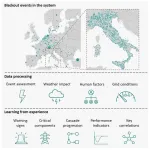(Press-News.org) Investigators from the Smidt Heart Institute at Cedars-Sinai found that an artificial intelligence (AI) algorithm can detect an abnormal heart rhythm in people not yet showing symptoms.
The algorithm, which identified hidden signals in common medical diagnostic testing, may help doctors better prevent strokes and other cardiovascular complications in people with atrial fibrillation—the most common type of heart rhythm disorder.
Previously developed algorithms have been primarily used in white populations. This algorithm works in diverse settings and patient populations, including U.S. veterans and underserved populations. The findings were published today in the peer-reviewed journal JAMA Cardiology.
“This research allows for better identification of a hidden heart condition and informs the best way to develop algorithms that are equitable and generalizable to all patients,” said David Ouyang, MD, a cardiologist in the Department of Cardiology in the Smidt Heart Institute at Cedars-Sinai, a researcher in the Division of Artificial Intelligence in Medicine, and senior author of the study.
Experts estimate that about 1 in 3 people with atrial fibrillation do not know they have the condition.
In atrial fibrillation, the electrical signals in the heart that regulate the pumping of blood from the upper chambers to the lower chambers are chaotic. This can cause blood in the upper chambers to pool and form blood clots that can travel to the brain and trigger an ischemic stroke.
To create the algorithm, investigators programmed an artificial intelligence tool to study patterns found in electrocardiogram readings. An electrocardiogram is a test that monitors electrical signals from the heart. People who undergo this test have electrodes placed on their body that detect the heart’s electrical activity.
The program was trained to analyze electrocardiogram readings taken between Jan. 1, 1987, and Dec. 31, 2022, from patients seen at two Veterans Affairs health networks. The algorithm was trained on almost a million electrocardiograms and it accurately predicted patients would have atrial fibrillation within 31 days.
The AI model was also applied to medical records from patients at Cedars-Sinai and it similarly—and accurately—predicted cases of atrial fibrillation within 31 days.
“This study of veterans was geographically and ethnically diverse, indicating that the application of this algorithm could benefit the general population in the U.S.,” said Sumeet Chugh, MD, director of the Division of Artificial Intelligence in Medicine in the Department of Medicine and medical director of the Heart Rhythm Center in the Department of Cardiology. “This research exemplifies one of the many ways that investigators in the Smidt Heart Institute and the Division of Artificial Intelligence in Medicine are using AI to address preemptive management of complex and challenging cardiac conditions.”
The study was a collaborative effort between physicians and investigators at Cedar-Sinai and the San Francisco and Palo Alto Veterans Affairs hospitals. In addition to Ouyang, Cedars-Sinai investigators Grant Duffy and John Theurer worked on the study.
The investigators plan to continue to study the algorithm as part of prospective clinical trials to learn if it helps identify those at risk for heart attack and stroke. They also plan to develop more AI algorithms.
Funding: The study was funded by the National Institutes of Health and the U.S. Department of Veterans Affairs.
END
Cedars-Sinai uses AI to identify people with abnormal heart rhythms
The algorithm may help clinicians find atrial fibrillation in people without symptoms
2023-10-18
ELSE PRESS RELEASES FROM THIS DATE:
How to build greener data centers? Scientists say crank up the heat
2023-10-18
Colder is not always better for energy-hungry data centers, especially when it comes to their power bills. A new analysis says that keeping the centers at 41°C, or around 105°F, could save up to 56% in cooling costs worldwide. The study, publishing October 10 in the journal Cell Reports Physical Science, proposes new temperature guidelines that may help develop and manage more efficient data centers and IT servers in the future.
“The cooling system accounts for over one-third of the data center’s total energy consumption, so many studies ...
As surging threats teeter electrical power grids, scientists offer insights to make them more resilient
2023-10-18
Power grids—the web of electrical networks that sprawl across countries and continents—are under stress. Extreme weather events and volatile energy demands often push the system to the brink. Although these high-impact events can be very damaging, often overlooked is the impact of minor disruptions that trigger a domino effect throughout the system, according to a study analyzing European power blackouts. The findings, published October 18 in the journal Joule, showed that recovering power within 13 hours can reduce up to ...
Telehealth supports retention in treatment for opioid use disorder
2023-10-18
Starting buprenorphine treatment for opioid use disorder through telehealth was associated with an increased likelihood of staying in treatment longer compared to starting treatment in a non-telehealth setting, according to a new study analyzing Medicaid data from 2019-2020 in Kentucky and Ohio. Published in JAMA Network Open, these findings add to a growing body of evidence demonstrating positive outcomes associated with the use of telemedicine for treatment of opioid use disorder.
In Kentucky, 48% of those who started buprenorphine treatment via telehealth remained in treatment for 90 continuous days, compared ...
Researchers design gene therapy that can effectively target glioblastoma
2023-10-18
In a first-in-human phase 1 trial in 41 patients with recurrent glioblastoma, an oncolytic virus treatment designed by Brigham researchers extended survival, especially among those with pre-existing viral antibodies
Therapy turns ‘immune desert’ into inflammatory cancer-fighting zone
Study demonstrated the safety and preliminary efficacy of a novel gene therapy for glioblastoma
Glioblastoma (GBM), an aggressive brain cancer, is notoriously resistant to treatment, with recurrent GBM associated with survival of less than 10 months. Immunotherapies, ...
From a five-layer graphene sandwich, a rare electronic state emerges
2023-10-18
Ordinary pencil lead holds extraordinary properties when shaved down to layers as thin as an atom. A single, atom-thin sheet of graphite, known as graphene, is just a tiny fraction of the width of a human hair. Under a microscope, the material resembles a chicken-wire of carbon atoms linked in a hexagonal lattice.
Despite its waif-like proportions, scientists have found over the years that graphene is exceptionally strong. And when the material is stacked and twisted in specific contortions, it can take on surprising electronic behavior.
Now, MIT physicists have discovered another surprising property ...
Treatment rates for mental disorders among children and adolescents
2023-10-18
About The Study: The results of this meta-analysis of 40 studies including 310,000 children and adolescents suggest that, in general, the treatment rates for mental disorders among children and adolescents were low, especially for depression and anxiety. Targeted intervention policies and effective measures should be designed and implemented to improve treatment rates of psychiatric disorders among youths.
Authors: Yuanyuan Xiao, Ph.D., of Kunming Medical University in Kunming, Yunnan, China, is the corresponding author.
To access the embargoed study: Visit our For The Media website at this link https://media.jamanetwork.com/
(doi:10.1001/jamanetworkopen.2023.38174)
Editor’s ...
Association of antepartum and postpartum air pollution exposure with postpartum depression in southern California
2023-10-18
About The Study: The findings of this study including 340,000 pregnant women suggest that long-term exposure to antepartum and postpartum air pollution was associated with higher postpartum depression risks. Identifying the modifiable environmental risk factors and developing interventions are important public health issues to improve maternal mental health and alleviate the disease burden of postpartum depression.
Authors: Jun Wu, Ph.D., of the University of California, Irvine, is the corresponding author.
To access the embargoed study: Visit our For The Media website at this link ...
Scientists uncover new way viruses fight back against bacteria
2023-10-18
A microscopic discovery will not only enable scientists to understand the microbial world around us but could also provide a new way to control CRISPR-Cas biotechnologies.
An international team of researchers led by Professor Peter Fineran from the University of Otago and Dr Rafael Pinilla-Redondo from the University of Copenhagen has published a study in the prestigious journal Nature revealing new way viruses suppress the CRISPR-Cas immune systems of bacteria.
Co-first author Dr David Mayo-Muñoz, of the Phage-host interactions (Phi) laboratory in ...
Single vaccine protects against three deadly strains of coronavirus
2023-10-18
DURHAM, N.C. – A vaccine designed to protect against three different deadly coronaviruses shows success in mouse studies, demonstrating the viability of a pan-coronavirus vaccine developed by researchers at the Duke Human Vaccine Institute.
Publishing in the journal Cell Reports, the single nanoparticle vaccine included components of a previous vaccine that was shown to protect mice and primates against multiple variants of SARS-CoV-2, which is the virus that causes COVID-19. In this study, the vaccine protected mice from SARS-CoV-1, another form of SARS coronavirus that can infect humans, and a MERS coronavirus that has led to periodic, deadly outbreaks ...
Milestone: Miniature particle accelerator works
2023-10-18
Particle accelerators are crucial tools in a wide variety of areas in industry, research and the medical sector. The space these machines require ranges from a few square meters to large research centers. Using lasers to accelerate electrons within a photonic nanostructure constitutes a microscopic alternative with the potential of generating significantly lower costs and making devices considerably less bulky. Until now, no substantial energy gains were demonstrated. In other words, it has not been shown that electrons really have increased in speed significantly. A team of laser physicists at Friedrich-Alexander-Universität Erlangen-Nürnberg ...
LAST 30 PRESS RELEASES:
KIST develops eco-friendly palladium recovery technology to safeguard resource security
Statins significantly reduce mortality risk for adults with diabetes, regardless of cardiovascular risk
Brain immune cells may drive more damage in females than males with Alzheimer’s
Evidence-based recommendations empower clinicians to manage epilepsy in pregnancy
Fungus turns bark beetles’ defenses against them
There are new antivirals being tested for herpesviruses. Scientists now know how they work
CDI scientist, colleagues author review of global burden of fungus Candida auris
How does stroke influence speech comprehension?
B cells transiently unlock their plasticity, risking lymphoma development
Advanced AI dodel predicts spoken language outcomes in deaf children after cochlear implants
Multimodal imaging-based cerebral blood flow prediction model development in simulated microgravity
Accelerated streaming subgraph matching framework is faster, more robust, and scalable
Gestational diabetes rose every year in the US since 2016
OHSU researchers find breast cancer drug boosts leukemia treatment
Fear and medical misinformation regarding risk of progression or recurrence among patients with breast cancer
Glucagonlike peptide-1 receptor agonists and asthma risk in adolescents with obesity
Reviving dormant immunity: Millimeter waves reprogram the immunosuppressive microenvironment to potentiate immunotherapy without obvious side effects
Safety decision-making for autonomous vehicles integrating passenger physiological states by fNIRS
Fires could emit more air pollution than previously estimated
A new way to map how cells choose their fate
Numbers in our sights affect how we perceive space
SIMJ announces global collaborative book project in commemoration of its 75th anniversary
Air pollution exposure and birth weight
Obstructive sleep apnea risk and mental health conditions among older adults
How talking slows eye movements behind the wheel
The Ceramic Society of Japan’s Oxoate Ceramics Research Association launches new international book project
Heart-brain connection: international study reveals the role of the vagus nerve in keeping the heart young
Researchers identify Rb1 as a predictive biomarker for a new therapeutic strategy in some breast cancers
Survey reveals ethical gaps slowing AI adoption in pediatric surgery
Stimulant ADHD medications work differently than thought
[Press-News.org] Cedars-Sinai uses AI to identify people with abnormal heart rhythmsThe algorithm may help clinicians find atrial fibrillation in people without symptoms


